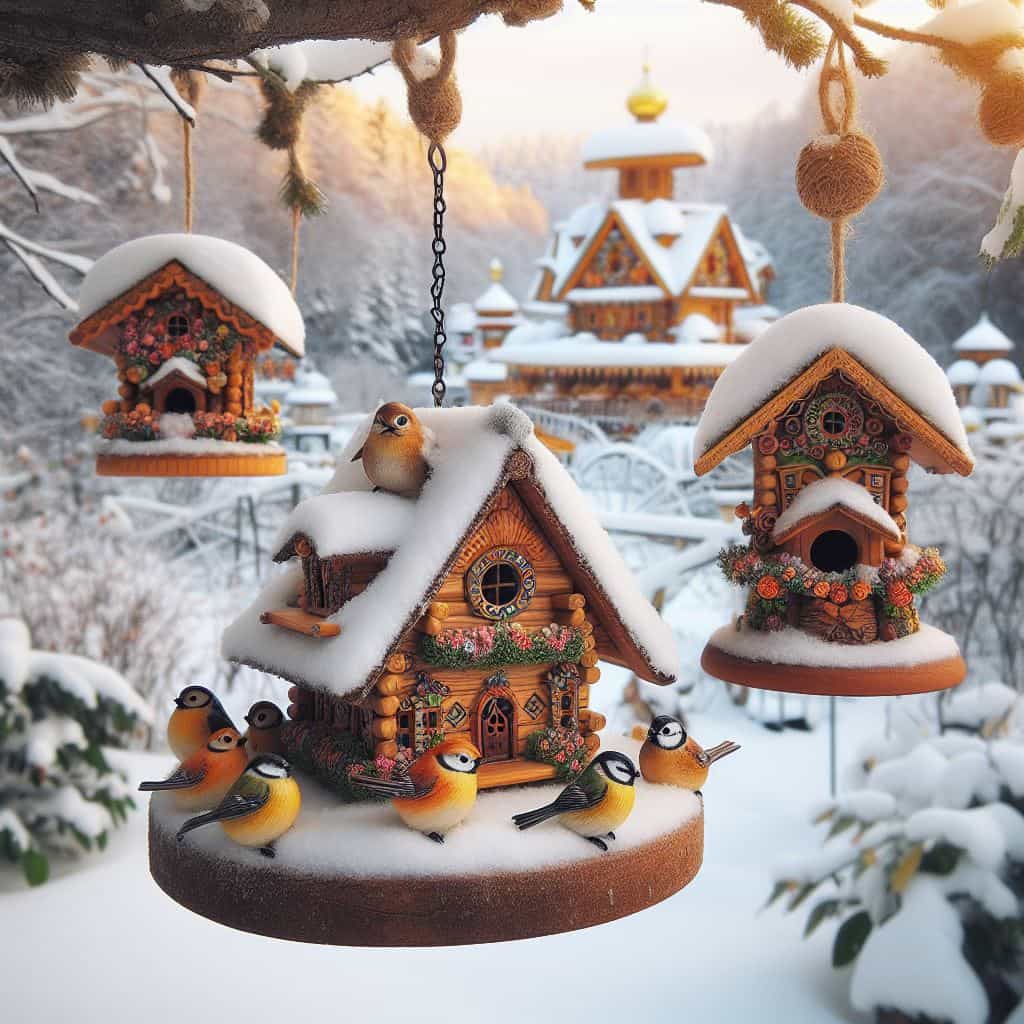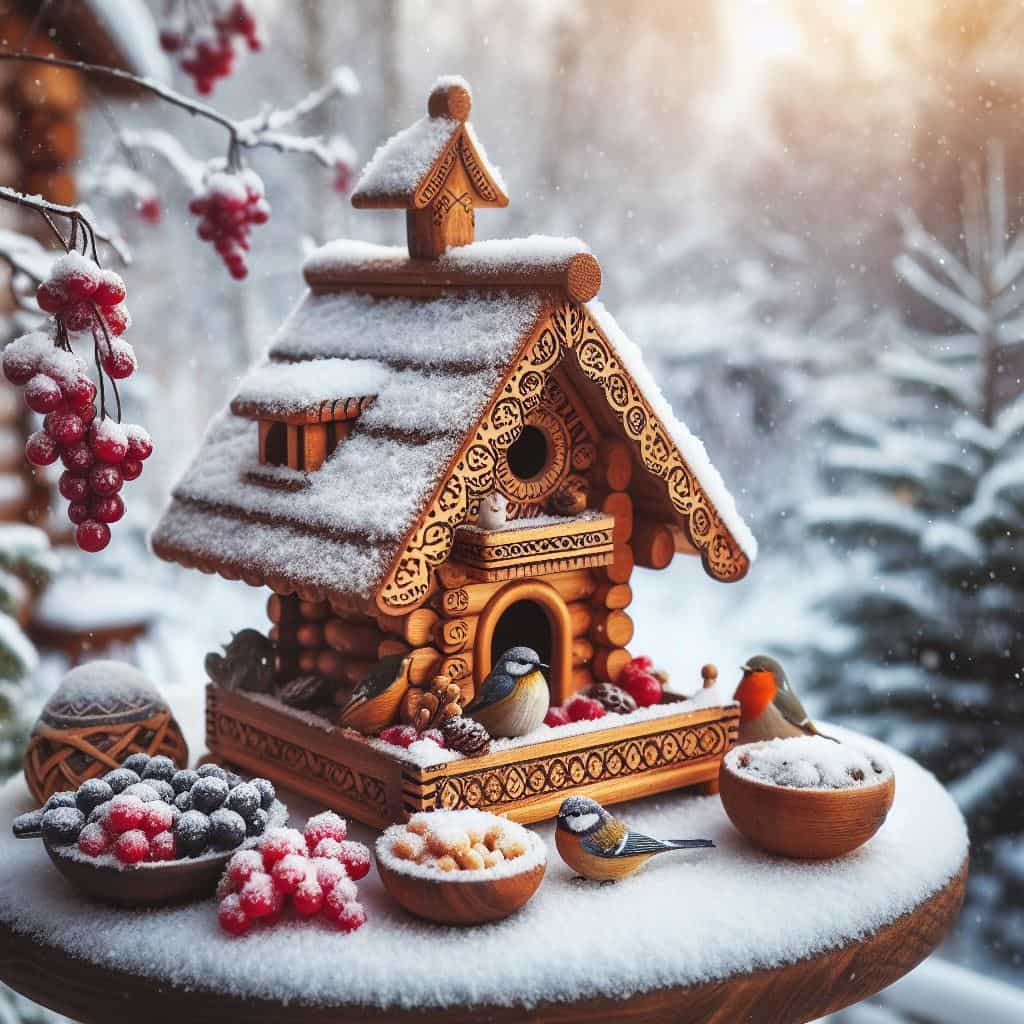In winter, when the ground is frozen and covered with snow, and trees have shed their leaves, feeding birds becomes not only a charitable act and a key to creating a unique atmosphere but also a guarantee of assistance to your garden. Here are three compelling reasons why attracting feathered friends to your corner of nature by building feeders is worthwhile
1. Combatting winter bird hunger
During the cold months, birds find it challenging, sometimes impossible, to locate food, especially under a blanket of snow and ice. Tits, like many other birds, can adapt to the absence of food and survive without it for several days, depending on various factors such as environmental conditions, the availability of other resources, health status, and more. In freezing periods, many small birds experience an increased need for energy to maintain body temperature and survive in such conditions. Prolonged lack of food can lead to the depletion of energy reserves and deterioration of the overall condition of the birds.
By providing birds with essential nutrients, you help them conserve energy and withstand winter hunger and cold. Consider how many tiny lives you can save by periodically offering them supplementary feeding!
2. Supporting biological diversity
Feeding birds enriches the variety of bird species in your garden, bringing joy through observation and strengthening the ecosystem of your garden. Even in winter, your garden will be teeming with life and cheerful activity!
3. Combating garden and orchard pests
If the two reasons above aren't convincing enough, here's a practical benefit: birds will frequent your garden, assisting in controlling harmful insects. Tits, larks, swallows, siskins, and other insect-eating birds play a role in "biological control" by preventing the unchecked reproduction of pests. They significantly contribute to fighting pests of fruit and ornamental trees, shrubs, berries, and vegetable crops, consuming not only insects but also their larvae. Some predatory birds, such as owls and hawks, may hunt mice and rats.
This natural control does not harm the environment, unlike chemical methods. Thanks to birds, the use of chemicals to combat pests can be significantly reduced. However, it is crucial to maintain a balance to avoid posing a threat to the health of the birds themselves.
Therefore, bird feeding in the winter garden is not just an act of care for them, not only a source of joy and pleasure for you, your children, and guests, but also a concern for green plantations. Create a reliable shelter and dining area for feathered friends, and your garden will be a place where life flourishes even in the winter season.

Bird Cafeteria: Ideal Houses and Feeders
When it comes to creating a bird haven in your winter garden, the right choice of feeders plays a crucial role. Let's explore various options to create the perfect spot for diverse birds:
1. Hanging Feeders:
Tube Feeders - Features and Advantages:
These long and narrow feeders are ideal for holding seeds and fat supplements without spillage, which is beneficial when using large seeds or other types of food. They are resistant to rain and snow, easy to fill and clean, and provide enough space for a flock of birds to comfortably use the feeder. Tube feeders often have an attractive, stylish design, serving as decorative elements in your garden or yard. Most of these cylindrical containers, made of materials like plastic, metal, or wood, have open or closed ends. If the walls are transparent, you can observe the birds inside. Typically, there are openings on the sides or the bottom of tube feeders, allowing birds access to the food. Many models come with a roof or shelter to prevent moisture and snow. Tube feeders can be attached to a tree branch, pole, or another suitable surface or suspended from a hook. The overall appearance of tube feeders can vary significantly, and we've outlined just the basic concept here.
Can a plastic water bottle be turned into a tube feeder?
While a plastic water bottle is not inherently a tube feeder, you can use it as an improvised feeder, especially if it has certain characteristics that meet birds' needs. Ensure the bottle is safe for use and doesn't contain harmful substances that could adversely affect bird health. For instance, you can prepare a plastic bottle feeder by:
- Making several holes in its side for birds to access the food, but not large enough for the food to spill out.
- Hanging the feeder on a branch with a rope or wire, ensuring it doesn't swing excessively in the wind. Although less efficient and convenient than specially designed tube feeders, this makeshift solution can be beneficial in temporary situations or as an economical option.
Plate Feeders - Their Advantages:
Plate feeders are a common type of hanging bird dining option. Wide and flat, they accommodate various types of feed, providing birds with an excellent view and ample space to choose their food. Adding a properly sized roof to these feeders enhances their benefits. The advantages of plate feeders also lie in their simplicity of construction.
Let's explore other types and groups of feeders:
1. Ground Feeders:
The most popular variations include:
- Platform feeders on a flat base for various types of feed.
- Platform feeders with a roof, ensuring long-term hygienic feeding for birds.
2. Smart Approach Feeders:
Here, we'll primarily highlight feeders with adjustable food dispensing. Equipped with a mechanism for regulating the food outlet, these feeders allow controlling the quantity of food and managing its consumption.
How to make a DIY feeder with an adjustable dispensing system?
Creating a feeder with an adjustable food dispensing system for birds can be an interesting and beneficial project. Here's a simple way to make such a feeder yourself:
Materials Needed:
- Wooden board for the base (approximately 20x30 cm).
- Wooden boards for the sides (approximately 10x30 cm).
- Thin wooden board or parchment (for making the dispenser).
- Wooden or metal rods (diameter around 1 cm), long nails, or screws.
- Handle for dose adjustment (e.g., screw with a nut).
- Drill or screwdriver.
- Saw.
- Measuring tape and ruler.
Process of Making the Food Dispenser:
- Determine the size of the dispenser and the depth of the feeder; cut the boards according to your design.
- Create the base: attach the side boards to the larger wooden board to form the sides of the feeder.
- Craft the food dispenser from the thin board or parchment. The size and shape depend on your preferences, but the dispenser should be large enough for birds to easily access the food. Add a dose adjustment handle, such as using a screw on one of the side boards to regulate the size of the dispenser opening.
- Secure the dispenser inside the feeder using long nails or screws. Ensure it is stable and easily adjustable.
- Hang the feeder, making sure it is securely attached, and the dose adjustment handle functions correctly.
We've provided a basic description, but feel free to make modifications to the structure and design of the feeder based on your preferences and available materials.

Let's address some common questions:
1. What materials are suitable for making feeders?
- Wood: Natural and attractive, but prone to wear due to weather conditions.
- Plastic: Lightweight, durable, easy to clean, ideal for hanging feeders.
- Metal:nSturdy and resistant to various conditions, suitable for ground feeders.
2. Where and at what height should feeders be placed?
- Install feeders at about one and a half to two meters above the ground for bird safety and convenient maintenance.
- Distance from obstacles: Ensure sufficient space around feeders for birds to land and take off. Avoid placing feeders near windows to prevent birds from colliding with transparent surfaces.
- Install feeders in locations inaccessible to small predators and cats.
- Secure mounting: Use sturdy hooks or ropes to prevent swinging and falling. Periodically check attachments and clean feeders of debris.
3. What to feed tits, siskins, and other small birds in winter?
In the cold season, birds have special nutritional needs due to limited access to natural food sources. Here are some types of food that can help small feathered friends survive the winter:
- Seeds of various plants: Tits particularly enjoy sunflower seeds. Provide not only sunflower seeds but also pumpkin seeds, barley, millet, and oats. Special wild bird feeding mixes are also suitable.
- Nuts: Siskins, tits, and other small birds appreciate walnuts and hazelnuts, providing valuable nutrients and energy.
- Fruits: Offer sliced pieces of apples, pears, berries, or dried fruits to add variety to their diet.
- Food balls: Use feed balls containing seeds, nuts, and fat. Easily hang them in the feeder, providing birds with extra calories for warmth, convenient, and nutritious feeding.
- Ensure birds have access to fresh water, even in cold months, as water is essential for their survival.
Conclusion
Creating cozy and reliable feeders for birds in your garden is not only an act of charity but also a wonderful opportunity to enjoy the picturesque bird ballet right outside your window. Installing various types of feeders in your garden reduces competition among birds for food and offers numerous opportunities for observation. Consider the specific features of your property when choosing feeder types, as each beautiful and functional feeder creates a unique appealing effect, providing both aesthetic pleasure and turning your garden into a true bird oasis in winter while protecting it from harmful insects in summer.
By following these recommendations, you will create the perfect bird cafe that attracts diverse visitors and brings your garden to life even on the coldest winter days.



